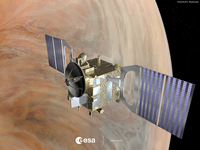3
3488
Guest
An UPDATE!!!!!!<br /><br />I thought it was an April Fools gag, but realised it was the 4th, not the 1st!!!!!!<br /><br />Interesting sense of depth in these clouds.<br /><br />==============================================================================<br /> <br />Venus' atmosphere represents a true puzzle for scientists. Winds are so powerful and fast that they circumnavigate the planet in only four Earth days - the atmospheric 'super-rotation' - while the planet itself is very slow in comparison, taking 243 Earth days to perform one full rotation around its axis. <br /><br />At the poles things get really complicated with huge double-eyed vortices providing a truly dramatic view. In addition, a layer of dense clouds covers the whole planet as a thick curtain, preventing observers using conventional optical means from seeing what lies beneath. <br /><br />Venus Express is on the contrary capable of looking through the atmosphere at different depths, by probing it at different infrared wavelengths. The Ultraviolet, Visible and Near-Infrared Mapping Spectrometer (VIRTIS) on board is continuing its systematic investigation of Venus' atmospheric layers to solve the riddle of the causes for such turbulent and stormy atmosphere. <br /><br />The images presented with this article focus on Venusian atmospheric turbulences and cloud features, whose shape and size vary with planetary latitudes. At the equator, clouds are irregular and assume a peculiar 'bubble'-shape. At mid latitudes they are more regular and streaky, running almost parallel to the direction of the super rotation with speed reaching more than 400 kilometres per hour. Going higher up in latitude, in the polar region, the clouds end up in entering a vortex shape. <br /><br />With its multi-wavelength eyes, VIRTIS can observe the atmosphere and the cloud layers not only at different depths, but also both in the day- and night-side of the planet - a characteristic that allows an overall assessment of the 'environmental' cau <div class="Discussion_UserSignature"> <p><font color="#000080">"I suddenly noticed an anomaly to the left of Io, just off the rim of that world. It was extremely large with respect to the overall size of Io and crescent shaped. It seemed unbelievable that something that big had not been visible before".</font> <em><strong><font color="#000000">Linda Morabito </font></strong><font color="#800000">on discovering that the Jupiter moon Io was volcanically active. Friday 9th March 1979.</font></em></p><p><font size="1" color="#000080">http://www.launchphotography.com/</font><br /><br /><font size="1" color="#000080">http://anthmartian.googlepages.com/thisislandearth</font></p><p><font size="1" color="#000080">http://web.me.com/meridianijournal</font></p> </div>




